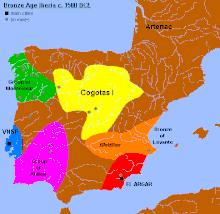 | |
| Geographical range | Southeast Spain |
|---|---|
| Period | Bronze Age |
| Dates | c. 2200 — c. 1300 BC |
| Major sites | El Argar, La Bastida de Totana |
| Preceded by | Bell Beaker culture, Millaran culture |
| Followed by | Motillas, Bronze of Levante, Post-Argar |
El Argar is an Early Bronze Age culture developed in the southeastern end of the Iberian Peninsula. It is believed to have been active from about 2200 BC to 1500 BC[1][2][3] The people developed sophisticated pottery and ceramic techniques that they traded with other Mediterranean tribes.[4]
The civilization of El Argar extended to all the current-day Spanish province of Almería, north onto the central Meseta, to most of the region of Murcia and westward into the provinces of Granada and Jaén, controlling an area similar in size to modern Belgium.[5]
Its cultural and possibly political influence was much wider. Its influence has been found in eastern and southwestern Iberia (Algarve), and it likely affected other regions as well.
Some authors have suggested that El Argar was a unified state.[5]
- ^ Lull et al., "Emblems and spaces of power during the Argaric Bronze Age at La Almoloya, Murcia,", Antiquity, Cambridge University Press, 11 March 2021
- ^ Lull, Vicente; Micó, R.; Rihuete Herrada, Cristina; Risch, Roberto (2011). "El Argar and the Beginning of Class Society in the Western Mediterranean". Archäologie in Eurasien. 24: 381–414.
- ^ Pinkowski, Jennifer (March 11, 2021). "She Was Buried With a Silver Crown. Was She the One Who Held Power?". New York Times.
- ^ Lull, Vincente; Micó, R.; Rihuete Herrada, Cristina; Risch, Roberto (2013). Bronze Age Iberia. Oxford University Press. pp. 594–616. ISBN 9780199572861.
{{cite book}}:|journal=ignored (help) - ^ a b Eiddon, Iorwerth; Edwards, Stephen (1973). The Cambridge Ancient History. p. 764.